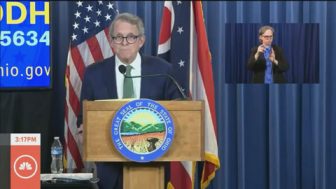By Julie Holderbaum, Minerva EA/OEA

During the past few months, Ohio’s teachers have found ways to creatively teach every content area while being separated physically from our students. It hasn’t been easy.
However, our struggles as teachers learning new technology and methods of teaching pale in comparison to the challenges of our students trying to learn from home. Few of them have a quiet workspace with a computer and ample time to engage with school assignments. Even in the best case scenarios, students are distracted by Netflix and TikTok, phones and video games. Most of my students face even greater challenges. They are taking care of younger siblings while their parents work, or they are working more hours at their own jobs to help with family expenses. Some of my students suffer from depression and anxiety, and now they are dealing with the world turned upside down. Sadly, in the worst cases, students are trapped at home with physically or mentally abusive family members and no escape to the safety of school.
Coupled with the fact that the learning environment at home can be problematic is the fact that there is great inequity in access to technology among Ohio’s families. A significant number of our students do not have access to the internet or the devices necessary to complete online work even in otherwise positive home learning environments.
A packet of work sent home is not the same as students being able to participate in a class meeting online or exchange emails with their teacher. It’s not the same as being able to view videos of their teachers explaining concepts, or watching their teachers work a math problem or edit a paragraph via a document camera.
Given the stressors that make learning from home difficult and the lack of technology that plagues many students, we can all agree that in-person education is in the best social and academic interest of our kids (and, frankly, our economy, because not every parent has a job that allows them to work from home when kids are not in school).
The task before us then is daunting and expensive: we need to deal with the technology gap in case a public health crisis again forces us to educate through remote learning, while at the same time make accommodations to ensure safe conditions for in-person learning.
I was hopeful that Governor DeWine would avoid making drastic cuts to school funding. I was even naive enough to hope the governor would find ways to provide more funding to public education.
 Instead, last week, the governor announced a “$300 million reduction in K-12 public-school funding, $210 million from Medicaid spending and $110 million from college and university funding.”[1] To my dismay, teachers, students, and the poorest Ohioans will bear the brunt of the budget cuts caused by the COVID-19 crisis.
Instead, last week, the governor announced a “$300 million reduction in K-12 public-school funding, $210 million from Medicaid spending and $110 million from college and university funding.”[1] To my dismay, teachers, students, and the poorest Ohioans will bear the brunt of the budget cuts caused by the COVID-19 crisis.
Interestingly, the Department of Corrections was spared from the budget ax, because “(prisons) have gotten to be more expensive to operate as state officials try to deal with COVID-19 outbreaks among prisoners and staff.”[2]
Aren’t schools going to become more expensive to operate as we try to deal with preventing outbreaks among students and staff? Schools are also a setting where a lot of people come in contact with each other in a relatively small space, which is why they were the first to be shut down when the dire nature of the situation became clear.
To return to school and keep our students and educators safe, nearly every aspect of the school day will need to be changed. Lunches, assemblies, large classes such as gym and choir, even one-on-one tutoring sessions will all have to be reconfigured. To achieve smaller class sizes, students might attend on alternate days or for half days. These modifications may require extra bussing, increased staffing, longer school operating hours, and at the very least, more daily cleaning and sanitizing. Furthermore, we need to be prepared to offer additional mental health services to help our students deal with the stress of returning to school or the trauma they endured while at home. Not knowing if or when something like this might happen again, we also need to ensure equal access to technology for all kids. And all of that equals MORE MONEY, not less.
Why not tap part of Ohio’s rainy-day fund? We are far beyond rain. We are past thunderstorms, tornadoes, and floods. We are close to “Sharknado” territory, and if that isn’t the time to use at least part of the rainy-day fund, when is? In actuality, we could use ALL of the rainy-day fund to avoid cuts in education and still have billions left over.
I know that OEA’s leadership agrees that we should tap into the rainy day fund. As Piet van Lier of Policy Matters Ohio noted “the state should have looked to the rainy-day fund now to help school funding, a move DeWine chose not to take,” and adding that “It’s just beyond comprehension that you could be doing that [cutting aid to schools] without turning over every stone.”[3]
Perhaps the cuts to school budgets made by the governor will be offset by the federal CARES (Coronavirus Aid, Relief, and Economic Security) Act. But the fact remains, if DeWine had not made the draconian cuts to education, any CARES money school districts receive could have actually been used to address the inequity issues and the need for creative solutions to resume in-person education, rather than to simply put local budgets on track to barely break even.
The governor likes to say we are “all in this together.” It doesn’t feel that way to me. It feels like educators, who have figured out how to completely change education in a matter of days, who are putting in more hours than ever before, who don’t even have time to say “we didn’t sign up for this,” are being taken advantage of. We’ve always stepped up, we’ve always figured out how to make do with the money we’re given, we’ve always done everything that has been asked of us and in such an outstanding manner that the governor has no reason not to expect that we won’t figure this out, too.
 We simply have to stop settling for monetary leftovers. We have to fight to make Ohio’s children the priority they should have been all along. We can’t count on Betsy DeVos or the current occupant of the White House to provide federal dollars to help the nation’s schools meet the new challenges we face. We can’t simply rely on union leaders or education-friendly state legislators to advocate for us and for our students. WE must fight for funding to address the new needs of our schools. WE must fight for safe conditions for us and our students to return to. WE must fight for equal access to technology for all kids.
We simply have to stop settling for monetary leftovers. We have to fight to make Ohio’s children the priority they should have been all along. We can’t count on Betsy DeVos or the current occupant of the White House to provide federal dollars to help the nation’s schools meet the new challenges we face. We can’t simply rely on union leaders or education-friendly state legislators to advocate for us and for our students. WE must fight for funding to address the new needs of our schools. WE must fight for safe conditions for us and our students to return to. WE must fight for equal access to technology for all kids.
We must let the governor and our elected representatives in Ohio and Washington DC know that we are willing to step up to the challenge that the COVID virus has brought to education, as we have demonstrated in stellar fashion during remote learning, but we need financial help to do so.
It is time to go on the offensive.
There are nearly 140,000 educators in Ohio[4]; imagine the power of some 140,000 people advocating for proper funding to take care of the needs of our students. We teach our students to stand up for what they believe in; are we doing that ourselves?
It’s worth contacting our U.S. Representatives and Senators to ask them to fight for funding from Congress. We have an even better chance of developing relationships with our state representatives and senators. A hand-written letter speaks volumes. An email also works and will allow you to quickly reach all of your legislators. Put your legislators’ office phone numbers in the Favorites on your phone so you can call them easily and frequently. Donate to the FCPE fund so that we can continue to elect legislators who support public education.
We need to make sure our leaders are hearing from educational experts. They might not seek out our opinion, but we must give it to them anyway, and hope that they have the good sense to listen to us when making decisions that impact education in Ohio.
The old cliche says that teachers shape the future. That has never been more true than now. It pains my heart to say it, but education may never be the same. We may never go back to “normal.” We have to prepare for that reality, and that means becoming teachers who advocate and argue for the funding we need to make the changes that will indeed shape the future of public education in a post-COVID 19 world.
— Julie Holderbaum is an English Instructor and an Academic Challenge Advisor at Minerva High School, Minerva, Ohio.
[1] “Ohio Gov. Mike DeWine announces $775m in state budget ….” 5 May. 2020, https://www.cleveland.com/open/2020/05/ohio-gov-mike-dewine-announces-775m-in-state-budget-cuts-to-education-medicaid-and-more.html. Accessed 6 May. 2020.
[2] “Ohio Gov. Mike DeWine announces $775m in state budget ….” 5 May. 2020, https://www.cleveland.com/open/2020/05/ohio-gov-mike-dewine-announces-775m-in-state-budget-cuts-to-education-medicaid-and-more.html. Accessed 6 May. 2020.
[3] “Coronavirus economic fallout ‘terrifies’ school leaders, experts ….” 8 May. 2020, https://www.cleveland.com/coronavirus/2020/05/coronavirus-economic-fallout-terrifies-school-leaders-experts-stirring-fears-of-deep-budget-cuts-merged-districts.html. Accessed 11 May. 2020.
[4] “Facts and Figures | Ohio Department of Education.” 11 Feb. 2020, http://education.ohio.gov/Media/Facts-and-Figures. Accessed 11 May. 2020.
